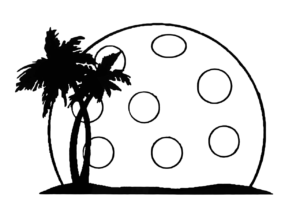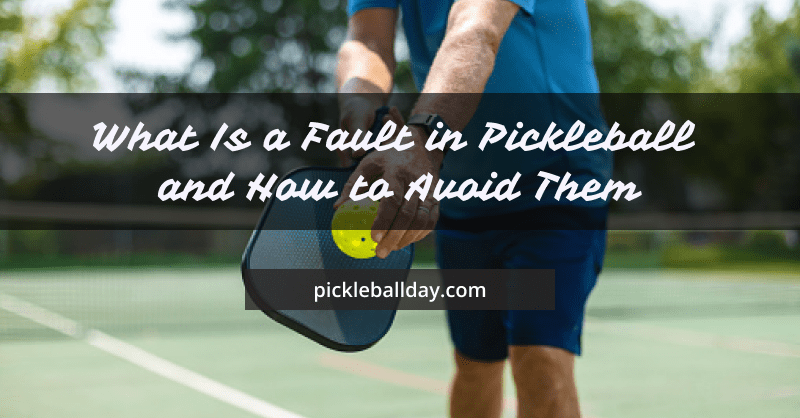Any rule violation in pickleball is a fault, and it happens for various reasons you should know. But why is avoiding mistakes so important? Faults, on the other hand, are the reasons you lose the option of serving and the benefits of scoring from serving. So it’s crucial to know all about the faults before you start the game.
In this article, I will describe all the faults that stop the game. You will also learn the reasons why faults occur in pickleball.
Let’s read to the end.
Table of Contents
What Is a Fault in Pickleball
In pickleball, a fault is a mistake or an action considered as the game’s rule violation. Any fault stops the game and starts with a new service. If the receiving team commits a fault, the serving team gets a point. Or when the serving team does something wrong, they lose the service or go side out. So your flaws give your opponents a good chance of scoring when they are the servers or receiving the service when they are the receivers.
Whenever you or your partner make two faults consequently, the service chance goes to your opponents. And you must know there are points when you are the servers and faults making you lose the chances to them. So without further ado, let’s see the usual reasons for faults.
10 Major Reasons for Which Fault Occurs
- The ball hits the net, either in a service or return.
- Any violation of the service rules.
- A serve miss to land within the confined playing area of the court.
- A ball bounces two times before the receiver can return.
- The receiver hits the ball out of bounds.
- A volley is taken before the ball gets a bounce on either side.
- A volley is taken from the kitchen or non-volley zone.
- While playing, a player touches the net or the net post. Even if any part of the player’s dress or paddle touches the net, the fault will be counted.
- While playing, the ball strikes or touches the player or their dresses or any other things they carry.
- The ball hits any other objects on the court before it has one bounce.
However, in the following sections, I will tell you in detail about the faults according to the ball’s position on the court, so that you are well aware of how to avoid them.
Faults That Occur During Serve
- The service must be done by the right-side player, behind the baseline.
- Missing to follow the two bounce rules, which means that a ball must need to be bounced once before the receiver returns and then again to be bounced once before the server returns. That means both teams allow two times to bounce before making a volley. Note that this is only for the first two shots after serving. No need to bounce every time unless the ball drops at the kitchen zone.
- None of the teams can ask for a time-out after serving.
- In singles, the ball can’t touch the body parts.
- In doubles, the service ball can’t come in contact with the server’s partner.
- Only one bounce is allowed before returning either by the server or the receiver. Two bounces are always a fault.
Faults Occur in Kitchen And Net Faults:
The kitchen is the area between the net and non-volley zone. The faults counted related to this area are:
- When you take serve from the kitchen it is always a fault.
- If the ball touches or hits the net, whether shot by the server or receiver, is a fault.
- If the ball touches the net stand, the same faults as the net are applied.
- The ball falling on the non-volley zone line is a fault.
Faults That Occur by Foot Fault
In pickleball, a foot fault occurs if you take a volley while you are in the kitchen area or the non-volley area. Also, while you take the service, don’t step on the outside of the centerline or baseline. You can’t even touch the baseline too.
Most Common Faults in Pickleball:
- Sidelines on the court are considered the fault line. The ball can touch your opponent’s sidelines and will be still considered inside the court. But if it falls outside the sideline, it’s outside the court and becomes a fault. And this is the most common fault.
- The ball touching your opposite side’s center line, sidelines, or baseline is considered in. On the other hand, the ball that falls on the non-volley zone line is a fault.
- The ball that lands outside the court marks a fault.
- Only the paddle can touch the pickleball, none of the dress, body parts, or your hand can touch the pickleball if it happens so, it’s a fault.
- The paddle can hit the balls, but hitting other objects like the net, net stands, or the floor, is a fault.
- Hitting the balls more than once is a fault.
- Don’t catch the ball thinking it’s gone outside the court, it’s also considered a fault.
How to Avoid Faults In Pickleball
Here I will tell you some effective suggestions to avoid faults, follow the tips:
- Practice More: As the old saying tells me practice makes a man perfect. But how to do that? I prefer you to practice more with your partners, which will help you build more muscle memory. You will certainly get advantages while playing in competitive matches.
- Know the Rules: Pickleball is not a random game. It’s a game with a specific set of rules, so it’s not hard to find out the fault rules and grab them well to avoid them during the game.
- Be Cautious in the Kitchen Zone: It’s the kitchen zone, where most faults occur. I prefer to play relaxed while you take the challenge to play from the front.
Frequently Asked Questions About Faults in Pickleball
Is Shouting Considered a Fault in Pickleball?
No. Any player shouting at his partner in the live match is not considered a fault but a signal.
Is Serving from Any Side Considered as Faults in Pickleball?
No, but the rule is to serve from the right side always, whether it’s a singles or doubles game. If any player who is on the left side mistakenly takes the service will be at fault.
How do faults occur in the pickleball “10-second rule”?
Any player must be on the right side to serve, and he only gets 10 seconds to take the service after the score is announced. If it’s more than 10 seconds, it’s a fault.
Final Verdicts
You might think the faults to be some kind of irritating rule as they stop the game. But those were only introduced to make your opponents abstain from unethical playing on the court. And a fair game is always fun and helpful for mental relaxation.
Now, you know the most common faults and how to avoid them. Practice them from the day you start this game, you will get used to making fewer faults over time.
Don’t miss the excitement Pickleball can provide you.


